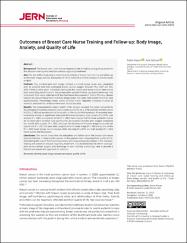| dc.contributor.author | Koçan, Sema | |
| dc.contributor.author | Gürsoy, Ayla | |
| dc.date.accessioned | 2023-10-12T07:59:06Z | |
| dc.date.available | 2023-10-12T07:59:06Z | |
| dc.date.issued | 2023 | en_US |
| dc.identifier.citation | Koçan, S. & Gürsoy, A.(2023). Outcomes
of breast care nurse training and follow-up:
Body image, anxiety, and quality of life. Journal of education and research in nursing, 20(1):52-59. http://doi.org/10.5152/jern.2023.45578 | en_US |
| dc.identifier.issn | 2757-9204 | |
| dc.identifier.uri | http://doi.org/10.5152/jern.2023.45578 | |
| dc.identifier.uri | https://hdl.handle.net/11436/8484 | |
| dc.description.abstract | Background: The breast care nurse has an important role in helping and guiding women in
the decision-making and selection process regarding treatment.
Aim: The aim of this study was to determine the effects of breast care training and follow-up
on the body image, anxiety, and quality of life of patients who had undergone breast cancer
surgery.
Methods: The pre-test–post-test design without a control group study was completed
with 34 patients who had undergone breast cancer surgery between May 2017 and May
2019. Patients were given individual training by the breast care nurse and an informative
book describing patient care in the perioperative period. A follow-up appointment was also
scheduled. Data were collected with the Functional Assessment of Cancer Therapy—Breast
Cancer, the Sexual Adjustment and Body Image Scale, the State-Trait Anxiety Inventory, and
questionnaires. Percentage, mean, paired samples t-test, repeated measures analysis of
variance, and post-hoc analysis were used to analyze data.
Results: The measurements taken 1 month after surgery revealed that when compared to
the preoperative period, patients’ state anxiety scores (41.14 ± 2.96) and trait anxiety scores
(42.35 ± 3.18) had decreased and the quality-of-life scores had increased. All recorded measurements showed a significant improved difference between state anxiety (P= .009), trait
anxiety (P < .001), and quality-of-life (P < .001) mean scores. Furthermore, patients’ scores
for all dependent variables had significantly decreased 6 months after surgery compared
to 1 month after surgery (P < .001), although the decrease in the body image score was not
significant (P > .05). One year after, surgical patients’ body image (P > .05) and quality-of-life
(P < .001) mean scores had increased, while the state (P= .009) and trait anxiety (P < .001)
mean scores had decreased.
Conclusion: The results show that the education and follow-up of the breast care nurse
may be effective in reducing the anxiety of the patients and increasing their quality of life.
Considering this role of the breast care nurse, who helps and guides women in the decisionmaking and selection process regarding treatment, it is recommended to inform and support women before surgery and discharge, to plan training accordingly, and to provide a
holistic and empathetic approach to patients | en_US |
| dc.language.iso | eng | en_US |
| dc.rights | info:eu-repo/semantics/openAccess | en_US |
| dc.subject | Anxiety | en_US |
| dc.subject | Body image | en_US |
| dc.subject | Breast care nurse | en_US |
| dc.subject | Quality of life | en_US |
| dc.title | Outcomes of breast care nurse training and follow-up: Body image, anxiety, and quality of life | en_US |
| dc.type | article | en_US |
| dc.contributor.department | RTEÜ, Sağlık Yüksekokulu, Hemşirelik Bölümü | en_US |
| dc.contributor.institutionauthor | Koçan, Sema | |
| dc.identifier.doi | 10.5152/jern.2023.45578 | en_US |
| dc.identifier.volume | 20 | en_US |
| dc.identifier.issue | 1 | en_US |
| dc.identifier.startpage | 52 | en_US |
| dc.identifier.endpage | 59 | en_US |
| dc.relation.journal | Journal of education and research in nursing | en_US |
| dc.relation.publicationcategory | Makale - Uluslararası Hakemli Dergi - Kurum Öğretim Elemanı | en_US |


















